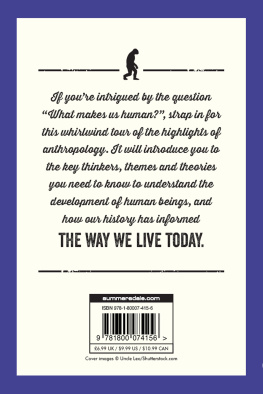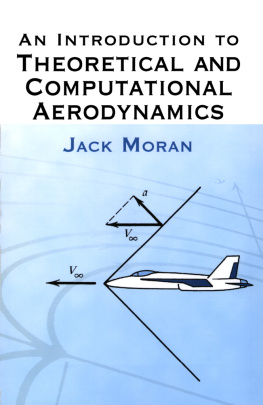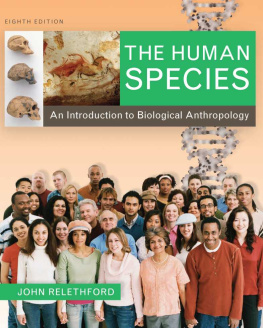First published 2016 by Westview Press
Published 2018 by Routledge
711 Third Avenue, New York, NY 10017, USA
2 Park Square, Milton Park, Abingdon, Oxon OX14 4RN
Routledge is an imprint of the Taylor & Francis Group, an informa business
Copyright 2016 by Taylor & Francis
All rights reserved. No part of this book may be reprinted or reproduced or utilised in any form or by any electronic, mechanical, or other means, now known or hereafter invented, including photocopying and recording, or in any information storage or retrieval system, without permission in writing from the publishers.
Notice:
Product or corporate names may be trademarks or registered trademarks, and are used only for identification and explanation without intent to infringe.
Designed by Trish Wilkinson
Set in 10 point Adobe Garamond
Library of Congress Cataloging-in-Publication Data
Moran, Emilio F.
Human adaptability : an introduction to ecological anthropology / Emilio F. Moran. 3rd ed.
p. cm.
Includes bibliographical references and index.
ISBN-13: 978-0-8133-4367-9 (pbk. : alk. paper)
ISBN-10: 0-8133-4367-4 (pbk. : alk. paper) 1. Human beingsEffect of environment on. 2. Adaptation (Physiology) I. Title.
GF51.M58 2008
304.2dc22
2007036237
ISBN 13: 978-0-8133-5027-1 (pbk)
To
Carlos Coimbra Jr. | Jonathan Hill |
Ricardo Santos | Peter Little |
Eduardo Neves | Mahir Saul |
Eduardo Brondizio | Maria de Lourdes Villar |
Andrea Siqueira | Janette Rawlings |
Fabio de Castro | Nicholar Shorr |
Maria Clara da Silva-Forsberg | Stefano Fiorini |
Mateus Batistella | Geoff Childs |
Celia Futemma | Lisa Cliggett |
Maria Angelica Toniolo | Brian Donahoe |
Francisco Gurri | Bret Ruby |
Nora Haenn | Martha Balshem |
Andreas Massing | Katherine Dettwyler |
and many other past students, now colleagues, always friends and scholarsand always an inspiration to me in trying to understand human-environment interactions. Thanks!
I dedicate this book to all of you!
Widespread use of this books earlier editions among environmental specialists in ecology, medical sciences, public health, geography, and anthropology has encouraged me to prepare a third edition. The first edition presented a systems approach that sought to overcome disciplinary biases restricting the development of holistic research and theory building. Over the years, readers have told me the book has contributed to this important task. I hope this new edition will continue to play a role in conceptualizing research and formulating our growing understanding of the multiple levels of adaptation under the increasingly rapid conditions of global environmental change.
In focusing on mechanisms of human adaptability, this book integrates findings from ecology, physiology, social anthropology, and geography around a set of problems or constraints posed by human habitats. This problem-oriented approach lends itself to the integration of data and at the same time orients the researcher toward answering the question, How do humans adapt, mitigate, accommodate, and respond to environmental changes?
The place of environmental studies in anthropology reflects the changing interests of the discipline as well as trends in society at large (Siniarska and Dickinson 1996). In the past twenty years some trends appear to favor disciplinary integration while other trends seem to exacerbate its fragmentation. This book is committed to multidisciplinary integration and to ensuring that our methods and theories speak to concerns of people who seek to achieve a workable and sustainable resource use system.
LOCAL AND REGIONAL ANALYSIS IN GLOBAL CONTEXT
One of the jewels in the practice of anthropology has always been its attention to the ethnographic detail of a village or community. More than simply a favored form of doing research, this became the only way we expected anthropological research to be carried out. This preference fit well with a desire to provide a holistic picture of human society, and it helped ecologically oriented anthropologists measure the relevant variables with some degree of completeness.
Or so we thought. This preference has become increasingly questionable as we have become more aware that the single village fails to adequately represent the range of variation present within even a limited region. Localized studies provide insights into family structure, subsistence strategies, labor inputs, health and nutritional status, flow of energy, socialization, and cultural institutions. Studies at this level, however, cannot address issues of origin and social evolution, economic development, demography, history, or political economy. These issues require a different type of research method emphasizing historical, geographic, economic, and political change over time and space (Moran 1990:286; Moran and Ostrom 2005). Studies based on a single village should not be expected to represent the range present in any population, and the construction of theory is set back by the unreliability of generalizing from single-site data. Even the most isolated human population and its immediate environment maintains a fluid set of relationships with other communities, opening it up to demographic, economic, and cultural exchange that over time alters the constitution of those same communities. Ellen demonstrated how this works itself out in the Moluccas (1990) and in a number of other ethnographic cases. Earlier, Rappaport (1968:226) had commented how, in retrospect, he had found the Maring local populations to be ephemeral through time and that the regional population would have been a more appropriate unit of study. A growing number of scholars have begun to consider local case studies in a regional context (Turner 2005; Aber and Foster 2004; Moran and Ostrom 2005).
This trend toward regional analysis gained further focus with the development of what has come to be known as human dimensions research. What is new in this approach is a concern for the cumulative impact of human action at a global scale (Lubchenco 1998). Research in this new multidisciplinary field concerns human activities that alter the earths environment, the driving forces or causes of these activities, the consequences of environmental change for human societies, and human responses to the expectation or experience of global change. Such research takes place at scales from local to global. It began with trying to understand causes, consequences, and responses to climate change events or its probability (for example, sea level rise, El Nio forecasts). It has also focused on impacts of climate change, on impacts of land use and land cover change on biodiversity, and on issues such as urban sustainability and globally significant resources such as water and energy (NRC 1992, 1994, 1998a, 1999a,b; Tillman 1999).










